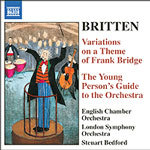
Variations on a Theme of Frank Bridge, Op. 10 / The Young Person's Guide to the Orchestra, Op. 34 / etc
 $25.00
Out of Stock
$25.00
Out of Stock6+ weeks add to cart
BENJAMIN BRITTEN
Variations on a Theme of Frank Bridge, Op. 10 / The Young Person's Guide to the Orchestra, Op. 34 / etc
London Symphony Orchestra / Steuart Bedford, conductor
[ Naxos / CD ]
Release Date: Tuesday 19 July 2005
This item is currently out of stock. It may take 6 or more weeks to obtain from when you place your order as this is a specialist product.
"A great jumping off point for listeners new to Britten's music. For us seasoned veterans, it is a fine revisit to some old favorites"
(MusicWeb Aug 2005)
"Another spectacular and poetic Britten collection ex-Collins courtesy of Naxos I wholeheartedly recommend this disc"
(MusicWeb Sept 2005)
"There's really no more that need be said: this is Britten at his best, in every respect, and a first-rate bargain to boot."
(10/10 ClassicsToday.com)
Benjamin Britten occupies an unrivalled position in English music of the twentieth century and a place of the greatest importance in the wider musical world. While Elgar was in some ways part of late nineteenth-century German romantic tradition, Britten avoided the trap offered by musical nationalism and the insular debt to folk-music of his older compatriots, while profiting from that tradition in a much wider European context. He may be seen as following in part a path mapped out by Mahler. He possessed a special gift for word-setting and vocal writing, a facility that Purcell had shown and that was the foundation of a remarkable series of operas that brought English opera for the first time into international repertoire. Tonal in his musical language, he knew well how to use inventively, imaginatively, and, above all, musically, techniques that in other hands often seemed arid. His work owed much to the friendship and constant companionship of the singer Peter Pears, for whom Britten wrote many of his principal operatic rôles and whose qualities of voice and intelligence clearly had a marked effect on his vocal writing.
Born in the East Anglian seaside town of Lowestoft in 1913, Britten showed early gifts as a composer, studying with Frank Bridge before a less fruitful time at the Royal College of Music in London. His association with the poet W.H.Auden, with whom he undertook various collaborations, was in part behind his departure with Pears in 1939 for the United States, where opportunities seemed plentiful, away from the petty jealousies and inhibitions of his own country, where musical facility and genius often seemed the objects of suspicion. The outbreak of war brought its own difficulties. Britten and Pears were firmly pacifist in their views, but were equally horrified at the excesses of National Socialism and sufferings that the war brought. Britten's nostalgia for his native country and region led to their return to England in 1942, when they rejected the easy option of nominal military service as musicians in uniform in favour of overt pacifism, but were able to give concerts and recitals, often in difficult circumstances, offering encouragement to those who heard them. The re-opening of Sadler's Wells and the staging of Britten's opera Peter Grimes started a new era in English opera. The English Opera Group was founded and a series of chamber operas followed, with larger scale works that established Britten as a composer of the highest stature, a position recognised shortly before his early death by his elevation to the peerage, the first English composer ever to be so honoured.
The works included here come from the period between 1937 and 1946. The earlier date is that of Britten's tribute to his teacher, his Variations on a Theme of Frank Bridge, Op. 10, which was written for and performed by the Boyd Neel Orchestra at the Salzburg Festival in the same year. The theme itself is taken from Bridge's Idyll, Op. 6, No. 2, for string quartet, and is first heard after the brief dramatic introduction. Britten had planned to relate each movement to an aspect of Bridge's character. With this in mind he suggested the Adagio as 'his integrity', later changed to 'his depth', followed by the March as 'his energy', the Romance as 'his charm', the Aria Italiana as 'his wit', later changed to 'his humour', the Bourrée as ' his tradition', the Viennese Waltz as 'his enthusiasm', the Moto Perpetuo adapted as 'his vitality', 'his sympathy or understanding' reflected in the Funeral March, 'his reverence' in the Chant, 'his skill' in the Fugue, and 'our affection' in the Finale. The work is, whatever the relevance of these personal analogies, a tour de force, a highly skilful exploration of the possibilities in writing for a small string orchestra. The poignant theme leads to a moving Adagio, followed by the first satirical movement, a March, a Romance in the spirit of France, and an Aria Italiana that parodies Rossini. The Bourrée Classique suggests Stravinsky at his most neo-classical and the Wiener Walzer, not completely acceptable at the time to some Salzburg critics, is Vienna seen through the eyes of Ravel. The virtuoso Moto Perpetuo provides a transition to the seriousness of the Funeral March and the dark-hued Chant. The Fugue, as has been pointed out, contains a number of references to other works by Bridge, whose theme returns in modified form in the Finale.
Tracks:
Occasional Overture
Variations on a Theme of Frank Bridge, Op. 10
Prelude and Fugue, Op. 29
The Young Person's Guide to the Orchestra, Op. 34



